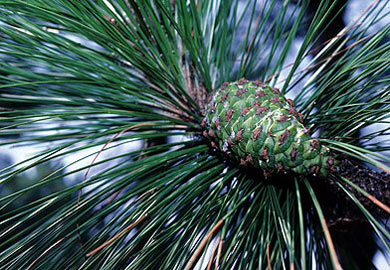DNR News
** Archived Article - please check for current information. **
July 24, 2014
Longleaf pine trees shedding needles is normal this time of year
Longleaf pine trees are shedding their needles across the sandhills and coastal plain, a normal occurrence this time of year, according to the S.C. Department of Natural Resources.
Many folks become alarmed when they see brown needles on longleaf pines, since the trees are, after all, classified as evergreen. But the term evergreen can be a bit misleading. Although longleaf does retain needles year-round, in years with abundant rainfall, individual bundles of needles generally remain on the tree for two growing seasons, and are shed in the fall.
The 2-year-old needles on longleaf pine trees are closer to the base of the branches than the younger needles, and so one easy way to tell if browning needles are a cause for concern or not is to note where they are found on the branch. If needles are browning at the base of branches, then likely this is a normal response to drought. By dropping needles early, the tree reduces its need for water. Wilting of leaves in many other plants is a similar response to drought, but differs in that the leaves usually remain on the plant. By wilting, the leaves expose less surface to the sun and wind and so the plant requires less water. If the stress is not too severe or of too long duration, wilted leaves can recover when the plant receives additional water. But browned needles do not reverse to green. If the needles are browning at the extreme ends of the branches, the problem might be something other than drought stress.
Johnny Stowe, S.C. Department of Natural Resources (DNR) forester and wildlife biologist, said trees are efficient at taking up, conserving and recycling nutrients. A high percentage of the nitrogen and phosphorus in pine needles moves back into the tree before the needles turn brown and fall off. Nutrients such as calcium and magnesium do not translocate when needles shed. Consequently, these nutrients are lost from the site in substantial quantities when straw is raked on a regular basis. In those situations, it may be is beneficial to fertilize occasionally to offset the loss of nutrients, especially on poor land where longleaf pine often grows.
Individual trees of the same species may drop needles a few weeks apart. Trees on dry sites tend to drop needles earlier than trees on wetter sites.
Other species of Southern pines, such as loblolly pine, tend to react similarly to drought, although longleaf tolerates dry weather best of all. Besides being more drought-resistant as compared to other Southern pines, longleaf is also less susceptible to damage from wind, fire, insects and diseases. For more information on longleaf pine, visit the Longleaf Alliance’s website.
More News
- Longleaf pine trees shedding needles is normal this time of year
- Register now for Barnwell State Park Family Fishing Clinic
- DNR Hunter Ed volunteer recognized for education efforts
- DNR, U.S. Forest Service to provide special youth dove hunt Sept. 6 in Union County
- Coastal Conservation Association helps DNR protect oysters
- Lights out for loggerheads
- New barrier-free fishing pier completed at Lake Edwin Johnson near Spartanburg
- State antler records down slightly this year
- Bat disease white-nose syndrome jumps from mountains to Midlands in South Carolina
- Apply online for deer lottery hunts beginning July 1
- Freshwater fishing trends
- Saltwater fishing trends
- S.C. weekly tidetable
- DNR video
- Archived news releases
